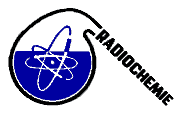Speaker
Ms
Marie Kubešová
(Nuclear Physics Institute, Czech Academy of Sciences)
Description
Multipurpose research reactors such as LVR-15 in Řež require frequent monitoring of neutron flux parameters (f, α) when k0 standardization in NAA is to be used. These parameters may change quite unpredictably, because experiments in channels adjacent to those used for NAA frequently require a change of the reactor operation parameters and/or active core configuration. For monitoring of the neutron flux parameters in each irradiation container the bare triple monitor method is very convenient. However, when using Zr-Au monitors we have observed quite some variations of f and α values as a function of irradiation and decay time employed. This was especially noticeable if the irradiation time was very short (in case of short-term irradiation induced activities of monitors are too low) or if the decay time before the first count of these monitors was longer than the recommended decay time of one day (the long-term irradiated samples may be too hot to be handled and/or measured one day after irradiation). Therefore, we have tested other sets of neutron flux monitors consisting of Au, Mo and Cr (Au, Mo and Sc in case of short-term irradiation) as proposed recently by Koster-Ammerlaan et al.1
Reference
1. M.J.J. Koster-Ammerlaan, M.A. Bacchi, P. Bode, E.A. De Nadai Fernandes, Appl. Rad. Isotopes, 66 (2008) 1964.
Primary author
Ms
Marie Kubešová
(Nuclear Physics Institute, Czech Academy of Sciences)
Co-author
Dr
Jan Kučera
(Nuclear Physics Institute, Czech Academy of Sciences)

